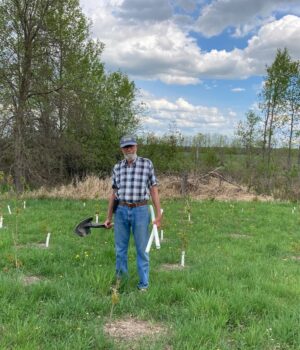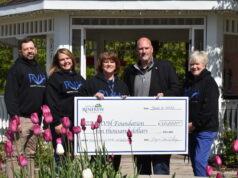Lynn Jones, Ottawa River Institute
Fifty-one years of planting trees on the Dobson Farm in the Upper Ottawa Valley
by Lynn Jones, Ottawa River Institute
Bob Dobson is a fifth generation farmer who operates a grass-fed beef farm in the Upper Ottawa Valley near Cobden, Ontario, 100 kilometers north-west of Ottawa.
In early May this year, Bob planted more than 500 trees on his farm, a mixture of oaks, pines, hickories and cedars. This was the fifty-first year in a row that Bob has planted hundreds to thousands of trees on the farm. He estimates he has planted 30,000 – 40,000 trees since starting the annual ritual back in 1972.
There is lots of talk these days about the benefits of planting trees, but back in 1972, there was not so much. So why did Bob embark on his epic tree planting venture? His answer to this question is simple and compelling.
As a 12-year old boy, the eldest of six siblings, Bob was tasked with fetching the cows from the pasture and bringing them to the barn for milking at the end of the day. The route from the pasture to the barn was down a shady, well-treed lane. On hot summer days it was a pleasant task to lead the cows down the cool, shady lane.
One year that changed. Government officials were encouraging farmers to get more efficient with bigger fields and bigger machinery. Bob’s father removed the trees and the lane to create a bigger field. He also removed fencerows — the uncultivated land including trees and shrubs on either side of fences— as did many other farmers across Ontario at that time.
Suddenly the task of bringing in the cows in the late afternoon on a hot summer day became much less pleasant. The striking difference between the cool shaded lane and hot, open treeless fields was a powerful lesson for a young lad of the value of mature trees and the shade they provide.
Tree planting was a top priority when Bob purchased the farm from his dad and began farming in the early 70’s. The invoice for his first purchase of trees from the Kemptville nursery is shown below—three thousand trees, half red pine and half white spruce for a total cost of $30, or one cent per tree!
Over the years, thousands of trees were planted in shelterbelts on the Dobson Farm, two to five rows of trees wide, across the prevailing winds. Shelterbelts are windbreaks that reduce erosion, slow the wind and keep more moisture (snow and rain) on the farm. They also provide shelter for livestock and homes for wildlife which in turn help to control insects and rodents. On a cool, windy day the warmer temperature on the protected side of the shelter belt is striking. Cattle sheltered from the wind are healthier, happier and need less feed to stay warm in winter!
Thousands of trees and shrubs were also planted in buffer strips alongside the creek that runs across the farm. Plantings include elderberry, cranberry and nannyberry bushes that provide food for birds. These fenced plantings and innovative watering systems that keep the cattle out of the creek while providing ample fresh water for them to drink, have transformed the creek from a barren, eroded area to a wildlife haven. The fully shaded creek and its treed banks are now teeming with birds including hawks, ducks, geese and herons. The creek water is cooler and supports a diverse population of frogs, minnows, muskrats, turtles and snakes.
Keeping carbon out of the atmosphere is of course the environmental cause du jour right now, and trees do that too. It has been estimated that a single oak tree can absorb as much as 48 pounds of carbon dioxide per year and sequester 1 ton of carbon dioxide by the time it reaches 40 years old. Based on those estimates, the thousands of trees on the Dobson Farm are doing important carbon sequestration work.
A lesser known benefit of tree planting is soil improvement. Tree roots make cracks in hard clay soil and over time make the soil more like a sponge. This reduces runoff and erosion during heavy rains. More precipitation is held in the soil resulting in a better ability to withstand drought.
Taking care of the land and enhancing biodiversity have been long-term goals on the Dobson Farm. Bob believes we must be good stewards of the land in order for our way of life to be sustainable well into the future. He feels strongly that human health is directly related to the environmental health of the farms that feed us.
Bob’s stewardship efforts have been widely recognized. In 1994 he won the first Environmental Stewardship Award from the Ontario Cattlemen’s Association. The award recognized outstanding projects on the Dobson Farm that enhance and protect waterways, create bird and wildlife habitat and provide shade and protection for both cattle and grassland. In 1996, Bob was awarded an Honorary Life Membership in the Ontario Institute of Agrologists and he was inducted into the Renfrew County Agricultural Hall of Fame in 2003. Over the years, Bob has provided hundreds of tours to farmers, students, agrology professors and others interested in learning about his innovative environmental stewardship initiatives. Delegations from as far away as China, Korea and Mexico have visited the farm to learn and be inspired.
Fifty-one years of planting trees on the Dobson Farm have set a wonderful example of how we humans can live in harmony with the ecosystems that sustain and support us. Encouraging widespread planting of shelterbelts and riparian buffer strips on Canadian farms would be a good thing. Purchasing trees and making them available at low cost (10 cents per tree) to farmers for this purpose would be an excellent use of our tax dollars!
Bob’s advice to anyone inspired to plant trees is “Do it!” He suggests planting non-invasive and indigenous species and a variety of species to protect against diseases and insects. He suggests protecting new transplants from rodents and deer, and having a plan to provide water to the new seedlings if the year of planting is especially dry. More information on the innovative farming practices on the Dobson Farm is available here.
Watershed Ways is a project of the Ottawa River Institute, a non-profit, charitable organization based in the Ottawa Valley. ORI’s mission is to foster sustainable communities and ecological integrity in the Ottawa River watershed.







![Kenopic/Smith Auction [Paid Ad]](https://whitewaternews.ca/wp-content/uploads/2018/10/advertising-100x75.jpeg)

